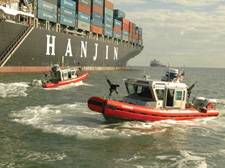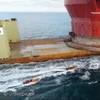The COFRs are Coming
Dennis Bryant, Senior Counsel, Holland & Knight LLP
On February 5, the US Coast Guard promulgated its long-awaited proposal for updating the Certificate of Financial Responsibility (COFR) program. Owners and operators of vessels over 300 gross tons operating in United States waters have been required to provide evidence of financial responsibility to respond to oil spills from their vessels since 1972. The program was significantly broadened with enactment of the Oil Pollution Act of 1990 (OPA 90), which increased the categories of damages for which oil spill liability could attach. The program is administered by the US Coast Guard’s National Pollution Funds Center (NPFC), which issued a Certificate of Financial Responsibility for the vessel once the owner or operator provides satisfactory evidence of financial responsibility.
The limits of liability established by OPA 90 were:
(a) For a tank vessel of greater than 3,000 gross tons, the greater of $1,200 per gross ton or $10 million;
(b) For a tank vessel of 3,000 gross tons or less, the greater of $1,200 per gross ton or $2 million; and
(c) For any other vessel, the greater of $600 per gross ton or $500,000.
Even though OPA 90 provided for periodic adjustment of the limits of liability to reflect significant increases in the Consumer Price Index (CPI), this authority was never exercised. Concern that the limits of liability were not keeping pace with the costs of oil spill response and damages began to be voiced with the tenth anniversary of OPA 90. These concerns culminated immediately after the oil spill in the Delaware River from the tanker ATHOS I on November 26, 2004. The spill was not due to any particular fault on the part of the vessel, which struck an uncharted obstruction in the river, but oil spill liability is strict, meaning that negligence is not at issue. Removal costs alone came to over $100 million and damages, while not yet finalized, are expected to be that much or more. The limit of liability of the ship owner, though, was approximately $45.5 million.
The Coast Guard and Maritime Transportation Act of 2006 included a section that made various changes to the limits of liability for oil spills. In an attempt to encourage tanker owners to transition more rapidly to double hulls, the provision set one level of liability for double hull tankers and another, higher level of non-double hull tankers. In addition, the liability level for all other vessels was raised significantly. This latter change was made in recognition that many cargo vessels carry significant quantities of bunkers that can be expensive to clean up and can cause significant damage.
The new limits of liability established in 2006 are:
(1) For a tank vessel of greater than 3,000 gross tons without a qualifying double hull, the greater of $3,000 per gross ton or $22 million;
(2) For a tank vessel of greater than 3,000 gross tons with a qualifying double hull, the greater of $1,900 per gross ton or $16 million;
(3) For a tank vessel of 3,000 gross tons or less without a qualifying double hull, the greater of $3,000 per gross ton or $6 million;
(4) For a tank vessel of 3,000 gross tons or less with a qualifying double hull, the greater of $1,900 per gross ton or $4 million; and
(5) For any vessel other than a tank vessel, the greater of $950 per gross ton or $800,000.
Due to the way the statute was worded, not all the increases in the limits of liability came into effect simultaneously. The measure was signed into law on July 11, 2006, and increase for non-tank vessels occurred immediately. The increases for tank vessels, though, did not occur until October 9, 2006. Notices of the increases were distributed by the NPFC and various marine insurers. Many ship owners and operators took steps to keep their liability insurance coverage commensurate with these increases.
The COFRs, though, remained unchanged. There was no direct link between the OPA 90 limits of liability and the requirement for vessel owners and operators to provide evidence of financial responsibility. So, for example, the owner of a single-hull tanker of 50,000 gross registered tons would only have to provide evidence of financial responsibility at the level of $60 million, even though it true potential liability is $150 million. It should be noted that many, if not most, ship owners carry liability insurance in the range of $300 million, but the potential gap is discomforting.
The NPFC has now taken the first step toward closing that gap. The February 5 proposal, when finally adopted, will raise the evidence of financial responsibility (and thus the COFR) requirements to match those of the 2006 statutory change in the limits of liability. This action will, when completed, require all ship owners and operators to obtain and maintain full liability insurance coverage, not just the pro-active ones that have taken this step already.
There is more, though, to the proposal than just aligning the COFR regulations with the statutory limits of liability. First, the proposal will correct various typographical and wording errors and eliminate some out-dated provisions. It will also bring the COFR requirement into the 21st century by eliminating the paper COFR and converting entirely to an electronic COFR (E-COFR). The E-COFR will be issued over the Internet. There will be no requirement in the updated NPFC regulations for a COFR to be carried on the ship, although having a copy in the ship’s records is probably the best practice. The Coast Guard now acknowledges the reality that its personnel check on the computer for the status of the ship’s documents (including the COFR) prior to departing the office to board the ship. Since other agencies, such as Customs and Border Protection (CBP), may not have such convenient access to the USCG database, it will be beneficial to have a paper copy of the E-COFR in the event of inquiry.
The COFR application fee is scheduled to be increased from $150 to $200 and the COFR certification fee is to be increased from $80 to $100. These proposed increases are intended to roughly approximate fluctuations in the Consumer Price Index since the fees were last changed in 1994.
In order to account for the required tri-annual adjustment in the limits of liability, the regulations will be reorganized to place those provisions in a separate subpart that will be easier to amend. At the same time, the portion of the regulation establishing the amount of financial responsibility for which the applicant must provide evidence will reference the limitation of liability subpart. Thus, the COFR amount will, in the future, automatically change in conjunction with the adjustments to the limits of liability. A point that is addressed in a February 13 correction to the earlier proposal is the effective date of these COFR increases. The Coast Guard now proposes that each ship must obtain the new COFR with its higher financial responsibility levels, within 120 days after promulgation of the final rulemaking in the Federal Register. For the future, each ship would also be required to obtain a new COFR each time the limit of liability is increased (this would occur on at least a tri-annual basis). This aspect of the proposal raises two issues. First, is 120 days an adequate time for arranging for a new COFR? For large, sophisticated companies, clearly this will not present a problem. For small companies, particularly ones whose ships only occasionally call in US ports, more time to learn of the change and then budget for and obtain the insurance cover may be necessary. Second, should a ship that has only recently acquired a COFR at the lower level receive a discount or rebate due to having to pay fees to acquire a new COFR when the old one has an expiration date over two years in the future? If this were a commercial enterprise, the answer would almost certainly be yes; a discount or rebate would be expected. Since this is a government operation, though, the COFR applicant should not hold his or her breath. Because of this unfortunate reality, it is recommended that the Coast Guard make it abundantly clear that the COFR will remain valid until the expiration of three years following issuance, until 30 days following notification by the financial guarantor of termination of its coverage, or until 120 days after the USCG has promulgated a change in the limits of liability, whichever occurs first.
Other than the issues discussed immediately above, the proposed changes to the oil spill financial responsibility regulations appear on first reading to be both consistent with the underlying statutes and reasonably progressive. It is recommended that owners and operators of ships impacted by these regulations carefully review the proposal, submit timely comments, and make preparations to comply with the changes that are inevitably coming.
(Source: Maritime Reporter & Engineering News: March 2008 edition)













